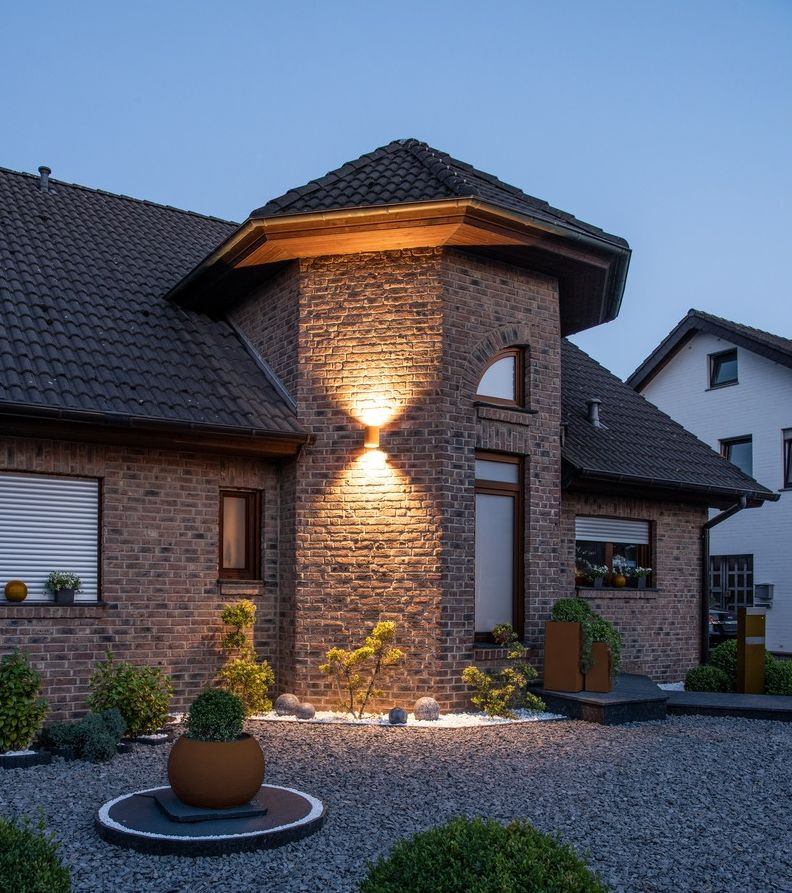Sometimes it could be so simple: you have completed your project in the living room, did not have to attack the calculated buffer of the recessed floor spotlights and could actually continue right away in the outdoor area. Anyway, it would create a uniform image if the recessed spotlights from the living room were also to be found on the terrace. It certainly would! However, this is rarely a good idea. Because inside is not the same as outside and the type of installation should also be taken into account when choosing the right lamp.
Conditions in the driveway and garden are completely different. If it is warm and dry indoors, we can expect wetness and cold outdoors – depending on the season. This also means completely different challenges for the installed lamps. Challenges that you should take into account when selecting a light. However, if you consider the following five points, nothing will stand in the way of a successful lighting installation.
Rule 1 : Only install lamps made of rustproof material.
Exposure to moisture lurks everywhere outside, and not only in the rain or cold. Excessive humidity in the summer also takes its toll on the lamp body. It is therefore particularly important to use corrosion-resistant, i.e. rust-free material. Where the lamp is installed in the garden or terrace is irrelevant. Only use lamps made of stainless steel or aluminium, for example. You are also on the safe side with copper or brass and do not have to worry about complaints. Important: Screws or other composite material used should also meet these requirements.
Rule 2 : Look for lamps with a protection rating of at least IP44.
Water can damage the lamp not only from the outside. If moisture penetrates the inside of the lamp, it can not only cause a defect. It can also lead to life-threatening injuries – and not only for children playing nearby. That is why all lamps you install outdoors must have a protection rating of at least IP44. Then they will not be affected by splashing water, no matter which direction it comes from. Near a pond or pool, however, you should go straight for IP65. Outdoor Lights with this degree of protection are not even affected by water jets.
Rule 3 : Ensure a secure connection in the ground as well.
By choosing the right material and protection class, you are on the safe side, especially with regard to the appearance of the outdoor lamps. However, what is not immediately visible is almost more important: the right connection. Power cables and co. must also be protected from the weather. Moreover, not every cable is designed for installation in the ground. So make sure you use the right material here, too.
After all, it has the most important job: it supplies the installed lamps with the necessary electricity. It goes without saying that the connection of the lamps to the mains must also be watertight. This is the only way to protect yourself and your customers from short circuits and their undesirable side effects.
Recessed floor lamps pose special challenges in this respect. Very few like standing water. So never install them in depressions or recesses and make sure there is drainage below the recessed box. If the humidity is very high during installation, moisture can accumulate inside the lamp. It is therefore better to postpone the installation until the next dry day.

Rule 4 : Choose the right type of lamp for the different outdoor applications
We now know some basic characteristics that distinguish outdoor lights from their indoor counterparts. Now it’s time to put this knowledge to good use. In plain language, this means: choose the right outdoor lamps on the desired installation location. We are not only referring to the type of protection and material. The type of luminaire also plays a decisive role.
If the lamps are to be used as wayfinding systems, for example, the choice can be narrowed down to recessed ground spotlights, path luminaires and bollard lamps. Things become even more detailed when the recessed ground lights are installed in the driveway and thus have to withstand the weight of different vehicles. But wall lamps also serve a different purpose in the entrance area than perhaps on a terrace or balcony. So both functionality and appearance play essential roles here.
Take this into account in your planning and opt for sensor luminaires wherever there are pathways, for example.
Rule 5 : Create a unified lighting image with lamp designs that match the ambience
If different installation locations also require different lamp types, this does not necessarily mean that you have to do without a uniform light and luminaire image. SLV product families and series are characterised by the fact that a uniform luminaire design is reflected in different luminaire types. In this way, you get ceiling, wall and free-standing luminaires with the same look, thus creating a uniform lighting image. Above all, this creates calm in the eye of the beholder and a pleasant atmosphere.